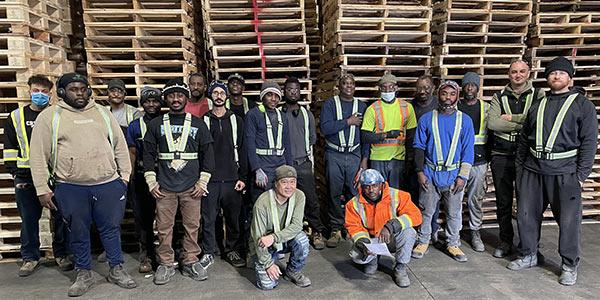Living wage
Employers in Peel can help reduce poverty by paying wages that meet employees' needs. The 2025 living wage is $27.20.
The living wage rate:
- Is not the same as the minimum wage, which is the legal minimum all employers must pay.
- Considers the cost of rent, food, transportation, and related government taxes and transfers for households.
- Is recalculated annually to ensure it accurately reflects changes in cost of living.
Learn more about the living wage
Hear from living wage employers
A living wage is beneficial to every member of your organization, both individually and as a team.
Recruitment and retention
- Employees who earn a living wage experience better mental and physical health and economic well-being.
- Employers paying a living wage experience a decrease in employee turnover, absenteeism, increased retention and productivity, and savings on hiring and retraining.
- Employers can use a living wage as a tool within their recruitment strategy for lower-paying occupations.
Strengthening and exemplifying corporate values
- Living wage employers receive public recognition for demonstrating a commitment to socially responsible practices, making them more attractive to potential employees, customers, and shareholders.
- Paying a living wage, promoting fair wages, and aligning with the Environment, Social and Governance (ESG) ethical movement is an act of Corporate Social Responsibility.
It's important for organizations in Peel to pay a living wage because:
Poverty affects productivity and employment stability.
8.6% of Peel's population live in poverty. This includes 9.5% of children aged 0 to 17.People who live in poverty have higher rates of chronic illness and reduced levels of emotional and mental development, which can affect productivity and employment stability.
Employee turnover costs employers.
Employee turnover and sick leave cost organizations 30% or more of their annual salary to replace.Paying a living wage is linked to a decrease in employee turnover and absenteeism, which can save hiring and retraining costs.
Nearly half of people who work in Peel work part time.
48% of those employed in Peel work part-time or part of the year.For years, the minimum wage has been too low to lift even someone working full-time, year-round, above the poverty line. It's even worse for part-time workers.
Just over half of Peel's immigrant population is working in poverty.
Working poverty is when a family - with at least one working person — has a household income that keeps them below an officially recognized poverty line. It can be fixed with effective policy and practice changes, such as adopting a living wage policy.Working poverty is more concentrated in immigrants and visible minorities. 51% of Peel's population are immigrants.
The Living Wage Employer Program celebrates employers that pay their direct and indirect employees a living wage.
Living wage employers are accountable employers who care about their employees and the community.
Most of all, they know that paying a living wage means investing in the long-term prosperity of the local economy by developing a loyal, skilled, and healthy workforce.
Becoming a living wage employer happens in 5 stages.
Stage 1: Expression of interest
Review the Ontario Living Wage Network (OLWN)'s employer guide, complete the initial contact form, or email at poverty@peelregion.ca.
Stage 2: Application review and license agreement
Prepare and submit a draft implementation plan. You'll sign the licence agreement and pay the employer certification fee once your application is approved.
Stage 3: Certificate presentation
You'll be connected with the Peel Poverty Reduction Committee to arrange the presentation of your Living Wage Employer Certificate.
Stage 4: Recognition
Your organization will be publicly recognized through social media, events, and publications. It will also be listed in OLWN's employer directory and map and on this website.
Congratulations!
Be sure to enjoy the benefits of being a Certified Living Wage Employer and share how well it’s working for your organization.
Stage 5: Periodic review
Each year on the anniversary of your certification, you'll be sent a renewal survey and invoice for the annual employer certification fee. When the living wage calculation is updated, you’ll be contacted and informed of the new rate.
For more information on living wage and how to become a living wage employer in Peel, visit the Ontario Living Wage Network.
Peel region is currently home to 12 certified living wage employers serving Brampton, Caledon, and Mississauga.
These employers come from varying sectors which include but are not limited to:
- Brewing
- Cleaning professional services
- Credit unions
- Environmental and green tech
- Garments
- Landscaping
- Manufacturing
- Social services
For more information on current employers, visit Ontario Living Wage Network.
List of employers
- City Pallets Inc.
- Cutter&Buck Canada
- Ecosource Mississauga
- Food Bank Mississauga
- Green Canopy Tree Services
- Hellamaid*
- Meridian Credit Union*
- Pallet Pickup Canada Inc.
- People for Pools Inc.
- Quintessential Canada Inc.
- Sonnen Hill Brewing
- United Way Greater Toronto
*Companies or organizations with multiple locations across Peel region.

Ecosource
"At Ecosource, paying a living wage is more than a policy - it’s a reflection of our values. We’ve seen how this commitment empowers our team to thrive, strengthens our organization, and deepens our shared dedication to building a more sustainable, caring community."
-Britt McKee, Executive Director, Ecosource
Green Canopy Tree Services
“We wanted to help our employees remove the stresses related to making ends meet, as well as feel valued, appreciated and supported in their personal lives.”
- Irina Souiki--Lead Arborist & Owner, Green Canopy Tree Services.
City Pallets

“Our biggest asset is our employees, and we were looking for practical ways to ensure we were offering a fair living wage for sometimes a difficult job.”
-Philip Varley – President, City Pallets Inc.
Food Banks Mississauga

“As the first employer in Peel Region to have joined the Ontario Living Wage Network in 2021, We are advocating for every single person in our community to have a living wage, and that starts with us.”
- Daisy Yiu—Director of Marketing and Communications, Food Banks Mississauga.

Meridian Credit Union
“We believe in doing the right thing for our employees. The Living Wage program aligns with our values—it’s about fairness, respect, and helping our people thrive. It’s also part of our broader ‘Meridian for Good’ strategy, which focuses on social equity and financial inclusion.”
-Khurram Shazad, District Vice President